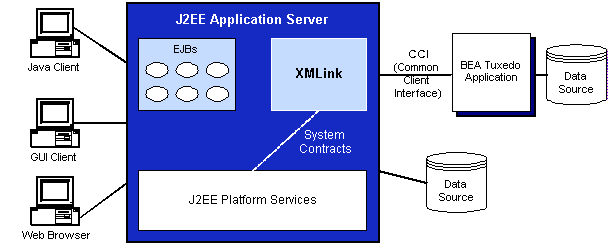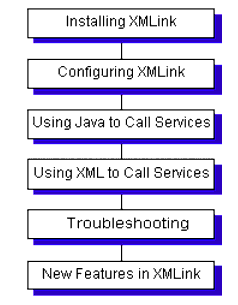




 | Using XMLink |     |
XMLink provides Java programmers, specifically those developing EJBs (Enterprise Java Beans), access to services developed as part of Oracle Tuxedo applications. Typically, XMLink integrates existing services in an Oracle Tuxedo application with a new application using Java and EJBs.
Java Compliance |  |
XMLink adheres to the J2EE (Java 2 Platform, Enterprise Edition) Connector Architecture (J2C) Specification, version 1.5. J2EE is designed to be used with multitiered, enterprise applications which separate the business logic and presentation aspects of applications from the system services provided by the J2EE platform. The addition of J2EE Connector to the J2EE platform allows integration of existing Enterprise Information Systems (EISs) to Java-based applications.
In the language of the J2C specification, XMLink is an outbound resource adapter and supports two deployment scenarios needed for J2EE compliance. J2EE resource adapters can either be run under the auspices of an application server (such as WebSphere) in which case they rely on services provided by the application server's framework, or they can be run in a non-managed environment, in which case they are local to a Java client and do not need an application server. This non-managed environment is conceptually similar to a two-tier application.
XMLink also implements an XML interface and the CCI (Common Client Interface) layer. The XML interface allows for data exchange in an XML format. The CCI API simplifies application access and development since developers can use the same set of API calls to connect to any underlying EIS.
The latest J2C specification, API documentation, and class files can be found at http://www.oracle.com/technetwork/java/javaee/index-138715.html.
Figure 1-1 XMLink in the J2EE Connector Architecture

What Oracle Tuxedo Features Are Supported |  |
The Oracle Tuxedo features to which XMLink provides access are:
XMLink also supports transaction demarcations using BEGIN, COMMIT, and ROLLBACK for Tuxedo 7.1 and later.
What Is In This Manual |  |
The chapters in this manual describe the tasks needed to install and deploy XMLink.




